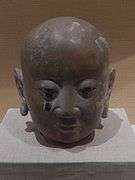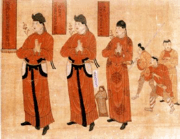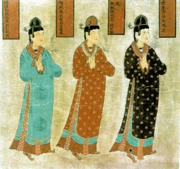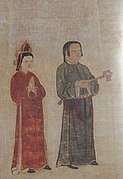Tangut people
| 党項 | |
|---|---|
| Regions with significant populations | |
| Western Xia | |
| Languages | |
| Tangut language | |
| Religion | |
| Buddhism, Shamanism | |
| Related ethnic groups | |
| Qiang (historical people) |
The Tangut first appeared as a tribal union living under Tuyuhun authority[1] and moved to Northwest China sometime before the 10th century to found the Western Xia or Tangut Empire (1038–1227). They spoke the Tangut language one of the Tibeto-Burman languages.[2]
Origin
The Tanguts are typically regarded by Chinese scholars to be synonymous with or at least related to the Qiang or Dangxiang (党項; Dǎngxiàng). Historically, "Qiang" was a collective term for the multiple ethnic groups who lived on the western borderlands of China. The name Tangut first appears in the Orkhon inscriptions of 735. In their own Tangut language, the Tanguts called themselves Mi-niah (Miñak). The Tanguts eventually migrated from their homeland in northeastern Tibet to the eastern Ordos region under pressure from the Tibetan Empire. By the time of the An Lushan Rebellion the Tanguts were the most dominant local power in the region. There they established the first and only Tangut state to have ever existed; Western Xia.[3]
Culture

Tangut society was divided into two classes: the "Red Faced" and the "Black Headed". The Red Faced Tanguts were seen as commoners while the Black Headed Tanguts made up the elite priestly caste. Although Buddhism was extremely popular among the Tangut people, many Tangut herdsmen continued to practice a kind of shamanism known as Root West. The black caps worn by Root West shamans give the Black Headed caste its name. According to Tangut myth, the ancestor of the Black Headed Tanguts was a heavenly white crane, while the ancestor of the Red Faced Tanguts was a monkey. Sources describe Tanguts as being short, stocky, dark-skinned, with thick lips. They wore their hair in the Tufa style, shaved bald except for a long fringe of bangs that framed the face.[4] Tangut kings went by the title of Wuzu.
According to sources in the Tangut language, the Tangut state known now as the Western Xia was named 𗴂𗹭𗂧𘜶 translated as "Great State of White and Lofty" (phôn¹ mbın² lhi̯ə tha²).[5] Although the Chinese translation of this name (Chinese: 白高大國; pinyin: Báigāo Dàguó) was occasionally used in Tangut sources,[6] the state was most commonly referred to as the "Great Xia" (大夏) in Chinese-language sources of the Tangut or as the "Xia State" (Chinese: 夏國) to the Song.[7] In later historiography and in modern Chinese the Tangut state is referred to as the "Western Xia" (Xī Xià 西夏). The Mongols and other steppe tribes referred to the Tangut kingdom as "Qashi" or "Qashin", which was derived from the Middle Chinese name for the region the Tanguts controlled (Chinese: 河西).
History
In 881 the Tanguts assisted the Tang in suppressing the Huang Chao rebellion. As a reward the Tang granted the Tangut general Li Sigong the three prefectures of Xia, Sui, and Yin as hereditary titles under the Dingnan Jiedushi.[3] From the Tanguts expanded their realm southwest towards their old homelands. In 1002 they conquered Ling Prefecture and set up their first capital there under the name of Xiping.[8] By 1036 they had annexed the Guiyi Circuit and the Ganzhou Uyghur Kingdom, even pushing into Tibetan territory and conquering Xining. The state of Western Xia was proclaimed in 1038.[9]
Since the Tangut's founder, Li Deming, was not a particularly conservative ruler, the Tangut people began to absorb the Chinese culture that surrounded them, but never lost their actual identity, as is proven by the vast amount of literature which survived the Tangut state itself.
Li Deming's more conservative son, Li Yuanhao, enthroned as Emperor Jingzong, sought to restore and strengthen the Tangut identity by ordering the creation of an official Tangut script and by instituting laws that reinforced traditional cultural customs. One of the laws he mandated called for citizens to wear traditional ethnic apparel and another required men to wear their hair short or shaved as opposed to the Chinese custom of wearing hair long and knotted. Rejecting the common Chinese surname of "Li" given to the Tuoba by the Tang court and that of "Zhao" given by the Song court, he adopted a Tangut surname that is rendered as "Weiming" (Chinese: 嵬名). He made Xingqing (Chinese: 興慶, modern Yinchuan) his capital city.
In the thirteenth century, Genghis Khan unified the northern grasslands of Mongolia and led his troops in six rounds of attacks against the Western Xia over a period of twenty-two years (1205, 1207, 1209–10, 1211–13, 1214–19, 1225–27). During the last spate of the Mongol attacks, Genghis died in Western Xia territory. The official Mongol history attributes his death to illness, whereas legends claim that he died from a wound inflicted in these battles.
In 1227, the capital of Western Xia was overrun by the Mongols, who devastated its buildings and written records: all was burnt to the ground except its monastery. The last emperor was killed and tens of thousands of civilians massacred. However, many Tangut families joined the Mongol Empire. Some of them led Mongol armies, e.g. Cha'an, into the conquest of China. After the Yuan dynasty (1271–1368) was established, the Tangut troops were incorporated into the Mongol army in their subsequent military conquests in central and southern China. The Tangut were considered Semu under the Yuan class system, thus separating them from the North Chinese. As late as the Ming dynasty (1368–1644), there was evidence of small Tangut communities in Anhui and Henan provinces. The people including members of the royal clan emigrated to western Sichuan, northern Tibet, even possibly northeast India, in some instances becoming local rulers. [10][11][12][13] The Tangut people living in Central China preserved their language until at least the 16th century.
Religion
The Tanguts were primarily Buddhists. Tangut Buddhism was influenced by external elements. The entire Chinese Buddhist canon was translated into the Tangut language over a span of 50 years and published around 1090 in about 3700 juan. Buddhism in the Tangut state is believed to be an amalgamation of Tibetan and Chinese traditions, among which the Huayan-Chan tradition of Guifeng Zongmi (Chinese: 圭峰宗密, 780–841) and his master Huayan Chengguan was the most influential. A number of texts previously believed to be of native Tangut origin turned out to be translations of Khitan source texts. The degree of Tibetan impact on the formation of Tangut Buddhism still remains unexplored, especially in the light of new discoveries showing that Tangut Buddhism owed more to the local culture in North China than to pure Tibetan or Chinese influences. Texts belonging to the Tibetan Mahamudra tradition demonstrate that Tangut Buddhism initially evolved along the Karma Kagyu rather than Sakya lines of Buddhist transmission.
A number of Tangut Buddhist institutions, such as "Imperial Preceptor" survived the Tangut State itself and could be found during the Yuan dynasty. One of the more definite sources of Tangut Buddhism was Mount Wutai, where both Huayan and Tangmi flourished from the late Tang period up to the time of the Mongol invasion.
Solonin (2005: unpaginated) links the Tanguts, the Helan Mountains and the Chan teachings of both Kim Hwasang and Baotang Wuzhu:
The origins of the Tangut Chan can also be traced deeper than previously believed: information on Bao-tang Wu-zhu (保唐无住720~794) travels in North-Western China from the Notes on Transmitting the Dharma Treasure through Generations implies that at the period of 760's some sort of Buddhism was spread in the region of Helanshan, where the Tangut were already residing. Concerning the late 8th century Helanshan Buddhism, little can be said: the doctrines of the lu (律) school and the teaching of Sichuan Chan of Rev. Kim (金和尚) seem to be known there.[14]
Worship of Confucianism also existed in the Western Xia, which has led to some claims that the Tangut religion was rooted in Confucianism, but this was incomparable with the degree of popularity of Buddhism. Tangut literature is dominated by Buddhist scriptures while secular teachings including the Chinese classics were rarely available in the Tangut language.
The Tangut state enforced strict laws pertaining to the teaching of religious beliefs and rigorously screened potential teachers. Before he was allowed to teach, a newcomer entering the state from Tibet or India first had to seek the approval of local authorities. Doctrines taught and methods used were carefully supervised to ensure there was no possibility that the Tangut people might misunderstand the teachings. Anyone found to be a fortune-teller or charlatan faced immediate persecution. Deeming it contrary to Buddhist ethical beliefs, the Tangut state strictly forbade religious teachers from accepting compensation or reward for their teaching services.
Although the state did not support an official school of Buddhism, it did protect all religious sites and objects within the country's boundaries.
As in China, becoming a Buddhist monk required government approval and anyone found to have taken the vows of a monk without such government oversight faced severe punishment. Remarkably for the time, women played a role in Tangut religious practices by serving as nuns, a position that could only be held by a woman who had been widowed or who was an unmarried virgin.
Suchan (1998) traces the influence of the first several Karmapas upon the Yuan and Ming courts as well as the Western Xia, and mentions Düsum Khyenpa, 1st Karmapa Lama:
The first several Karmapas are distinguished by their important status at the Yuan and Ming courts of China where they served as the spiritual guides to princes and emperors. Their influence also extended to the court of the Tangut Xia Kingdom where a disciple of Dusum Khyenpa was given the title "Supreme Teacher" by a Tangut Xixia King[.][15][16]
Gallery

 Tangut men
Tangut men Tangut women
Tangut women Tangut servants
Tangut servants Tangut bride
Tangut bride
See also
- Tangut script
- Tangut language
- List of Tangut books
- Western Xia (also called the Tangut Empire)
References
- ↑ Skaff 2012, p. 38.
- ↑ van Driem, George (2001). Handbuch Der Orientalistik. BRILL. ISBN 90-04-12062-9.
- 1 2 Beckwith 2009, p. 171.
- ↑ Keping, Xenia. "Black Headed and Red Faced Tanguts." Kepping 0th ser. 0.1 (2004). KEPPING.NET. Russian Orthodox Mission In China, 2004. Web. 5 Mar. 2016. <http://kepping.net/pdfs/works/The_Black-headed_and_the_Red-faced.pdf>
- ↑ Kepping, Ksenia (1994). trans. George van Driem. "The name of the Tangut Empire". T'oung Pao. 2nd. 80 (4–5): 357–376.
- ↑ Fan Qianfeng 樊前锋. 西夏王陵 [Western Xia Imperial Tombs] (in Chinese). Xinhua News Agency. Archived from the original on 2012-03-20. Retrieved 2012-04-18.
- ↑ Dunnell, Ruth W. (1996). The Great State of White and High: Buddhism and State Formation in Eleventh-Century Xia. University of Hawaii Press. ISBN 9780824817190.
- ↑ Beckwith 2009, p. 172.
- ↑ Skaff 2012, p. 236.
- ↑ 西夏法制地理—关于契丹、党项与女真遗裔问题(三)
- ↑ 党益民:党项羌文明与西夏湮灭之谜
- ↑ 《王族的背影》作者:唐荣尧
- ↑ eds. Franke, Herbert & Twitchett, Denis (1995). The Cambridge History of China: Vol. VI: Alien Regimes & Border States, 907–1368. Cambridge: Cambridge University Press. p. 214.
- ↑ Solonin, K. J. (2005), Tangut Chan Buddhism and Guifeng Zong-mi, Chung-Hwa Buddhist Journal, No. 11, (1998). Taipei: Chung-Hwa Institute of Buddhist Studies. ISSN 1017-7132
- ↑ Rhie, Marylin & Thurman, Robert (1991). Wisdom and Compassion. New York: Harry N. Abrams. p. 236.
- ↑ Suchan, Tom (1998). The Third Karmapa Lama, Rang Jung Dorje (T: Rang 'Byung rDo rJe). Source: (accessed: January 29, 2008)
Bibliography
- Andrade, Tonio (2016), The Gunpowder Age: China, Military Innovation, and the Rise of the West in World History, Princeton University Press, ISBN 978-0-691-13597-7 .
- Asimov, M.S. (1998), History of civilizations of Central Asia Volume IV The age of achievement: A.D. 750 to the end of the fifteenth century Part One The historical, social and economic setting, UNESCO Publishing
- Barfield, Thomas (1989), The Perilous Frontier: Nomadic Empires and China, Basil Blackwell
- Barrett, Timothy Hugh (2008), The Woman Who Discovered Printing, Great Britain: Yale University Press, ISBN 978-0-300-12728-7 (alk. paper)
- Beckwith, Christopher I (1987), The Tibetan Empire in Central Asia: A History of the Struggle for Great Power among Tibetans, Turks, Arabs, and Chinese during the Early Middle Ages, Princeton University Press
- Beckwith, Christopher I. (2009), Empires of the Silk Road: A History of Central Eurasia from the Bronze Age to the Present, Princeton University Press, ISBN 0-691-13589-4
- Bregel, Yuri (2003), An Historical Atlas of Central Asia, Brill
- Drompp, Michael Robert (2005), Tang China And The Collapse Of The Uighur Empire: A Documentary History, Brill
- Ebrey, Patricia Buckley (1999), The Cambridge Illustrated History of China, Cambridge: Cambridge University Press, ISBN 0-521-66991-X (paperback).
- Ebrey, Patricia Buckley; Walthall, Anne; Palais, James B. (2006), East Asia: A Cultural, Social, and Political History, Boston: Houghton Mifflin, ISBN 0-618-13384-4
- Golden, Peter B. (1992), An Introduction to the History of the Turkic Peoples: Ethnogenesis and State-Formation in Medieval and Early Modern Eurasia and the Middle East, OTTO HARRASSOWITZ · WIESBADEN
- Graff, David A. (2002), Medieval Chinese Warfare, 300-900, Warfare and History, London: Routledge, ISBN 0415239559
- Graff, David Andrew (2016), The Eurasian Way of War Military Practice in Seventh-Century China and Byzantium, Routledge, ISBN 978-0-415-46034-7 .
- Haywood, John (1998), Historical Atlas of the Medieval World, AD 600-1492, Barnes & Noble
- Latourette, Kenneth Scott (1964), The Chinese, their history and culture, Volumes 1-2, Macmillan
- Lorge, Peter A. (2008), The Asian Military Revolution: from Gunpowder to the Bomb, Cambridge University Press, ISBN 978-0-521-60954-8
- Millward, James (2009), Eurasian Crossroads: A History of Xinjiang, Columbia University Press
- Needham, Joseph (1986), Science & Civilisation in China, V:7: The Gunpowder Epic, Cambridge University Press, ISBN 0-521-30358-3
- Rong, Xinjiang (2013), Eighteen Lectures on Dunhuang, Brill
- Shaban, M. A. (1979), The ʿAbbāsid Revolution, Cambridge: Cambridge University Press, ISBN 0-521-29534-3
- Sima, Guang (2015), Bóyángbǎn Zīzhìtōngjiàn 54 huánghòu shīzōng 柏楊版資治通鑑54皇后失蹤, Yuǎnliú chūbǎnshìyè gǔfèn yǒuxiàn gōngsī, ISBN 957-32-0876-8
- Skaff, Jonathan Karam (2012), Sui-Tang China and Its Turko-Mongol Neighbors: Culture, Power, and Connections, 580-800 (Oxford Studies in Early Empires), Oxford University Press
- Wang, Zhenping (2013), Tang China in Multi-Polar Asia: A History of Diplomacy and War, University of Hawaii Press
- Wilkinson, Endymion (2015). Chinese History: A New Manual, 4th edition. Cambridge, MA: Harvard University Asia Center distributed by Harvard University Press. ISBN 9780674088467.
- Yuan, Shu (2001), Bóyángbǎn Tōngjiàn jìshìběnmò 28 dìèrcìhuànguánshídài 柏楊版通鑑記事本末28第二次宦官時代, Yuǎnliú chūbǎnshìyè gǔfèn yǒuxiàn gōngsī, ISBN 957-32-4273-7
- Xiong, Victor Cunrui (2000), Sui-Tang Chang'an: A Study in the Urban History of Late Medieval China (Michigan Monographs in Chinese Studies), U OF M CENTER FOR CHINESE STUDIES, ISBN 0892641371
- Xiong, Victor Cunrui (2009), Historical Dictionary of Medieval China, United States of America: Scarecrow Press, Inc., ISBN 0810860538
- Xue, Zongzheng (1992), Turkic peoples, 中国社会科学出版社
External links
- http://www.omniglot.com/writing/tangut.htm
- http://kepping.net Last works and documents of Ksenia Kepping
- http://www.chinaknowledge.de/History/Song/xixia.html
- The Tangut Royal Tombs – Steinhardt, Nancy Shatzman. 1993. The Tangut Royal Tombs near Yinchuan. In Muqarnas X: An Annual on Islamic Art and Architecture. Margaret B. Sevcenko, ed. Leiden: E.J. Brill.